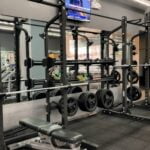Are you looking to improve your game on the netball court? In this article, we will delve into the world of fitness exercises for netball players. Fitness is a crucial component of excelling in netball, as it not only enhances performance but also reduces the risk of injuries. By incorporating specific exercises and routines into your training regimen, you can boost your endurance, strength, speed, agility, flexibility, and overall gameplay.
Netball is a fast-paced sport that requires quick movements, sharp reflexes, and sustained energy throughout a match. Therefore, having a solid fitness foundation is key to keeping up with the demands of the game. Whether you are a beginner or a seasoned player looking to take your skills to the next level, focusing on your fitness levels can make a significant difference in your performance on the court.
From warm-up routines to core exercises and recovery techniques, this article will provide you with a comprehensive guide on how to structure your workouts effectively. By targeting specific muscle groups involved in netball movements and incorporating cardio and strength training exercises tailored for the sport, you can enhance both your physical abilities and mental focus during gameplay.
Stay tuned as we break down each aspect of netball fitness and equip you with the tools to elevate your performance on the court.
Warm-Up Routine
Warming up before a netball game or practice is crucial to prevent injuries and improve performance on the court. A proper warm-up routine helps prepare the body for the physical demands of the game, increases blood flow to the muscles, and enhances flexibility. Here is a detailed guide on how to properly warm up before playing netball:
- Start with a light cardio activity such as jogging or skipping rope for 5-10 minutes to raise your heart rate and warm up your muscles.
- Perform dynamic stretches that mimic movements you will be doing during the game, such as leg swings, arm circles, and lunges with twists.
- Include exercises that activate key muscle groups used in netball like squats, leg lifts, and shoulder rotations to prepare them for action.
- Incorporate agility drills like ladder drills or cone drills to work on footwork, coordination, and quick direction changes.
Remember to listen to your body during the warm-up and adjust intensity as needed. By following a proper warm-up routine before playing netball, you can reduce the risk of injuries and ensure that your body is ready to perform at its best on the court.
Key Point: It is essential to include a variety of movements in your warm-up routine that target different muscle groups used in netball. This will help prepare your body for the specific demands of the game and improve overall performance during gameplay”.
Cardiovascular Exercises
Cardiovascular fitness is crucial for netball players as the sport requires constant movement, quick bursts of energy, and endurance to keep up with the pace of the game. By incorporating specific cardio workouts into your training routine, you can improve your overall performance on the court. Here are some tips on how to include cardiovascular exercises like running, sprinting, and agility drills to enhance your endurance and stamina for netball:
- Running: Long-distance running or interval training can help build cardiovascular endurance which is essential for maintaining stamina throughout a netball game. Incorporate runs of varying distances and speeds to simulate the demands of a match.
- Sprinting: Short sprints are excellent for improving acceleration and speed on the court. Include shuttle runs or hill sprints in your training regimen to work on explosive power and quick movements required in netball.
- Agility Drills: Agility drills such as ladder drills, cone drills, or shuttle runs can help improve footwork, coordination, and reaction time during gameplay. These drills also enhance change-of-direction capabilities which are essential in netball.
By consistently incorporating these cardiovascular exercises into your training routine, you can increase your aerobic capacity, improve your cardiovascular health, and boost your overall performance on the netball court. Remember to tailor your workouts to mimic the intensity and duration of a typical game to ensure you are adequately prepared for the physical demands of playing netball.
Strength Training
One effective strength training exercise for netball players is squats. Squats target the muscles in the legs, particularly the quadriceps, hamstrings, and glutes. These muscles are essential for explosive movements like jumping and running on the court. Performing squats with proper form and adding variations like jump squats or weighted squats can help increase lower body strength and power.
Another key area to focus on in netball strength training is the core. Core strength is vital for stability, balance, and overall movement efficiency during games. Exercises such as planks, Russian twists, and mountain climbers can help strengthen the abdominal muscles, lower back, and obliques. A strong core not only improves athletic performance but also reduces the risk of back injuries common in sports like netball.
Moreover,
| Exercise | Muscle Group Targeted |
|---|---|
| Squats | Legs (Quadriceps, Hamstrings, Glutes) |
| Planks | Core (Abdominal Muscles, Lower Back) |
Speed and Agility Drills
Speed and agility are crucial components of a successful netball game. To excel in these areas, players must engage in specific fitness exercises for netball that focus on improving acceleration, deceleration, and overall speed on the court. Incorporating drills that target these aspects can significantly enhance a player’s performance during gameplay.
One effective speed drill for netball players is shuttle runs. This exercise helps improve initial acceleration, change of direction, and agility on the court. Setting up cones at varying distances and sprinting back and forth between them at high intensity can simulate the quick movements required during a match. By regularly practicing shuttle runs, players can develop the explosiveness needed to react swiftly to different situations during gameplay.
Another important aspect to focus on is deceleration. This skill is crucial in netball as players need to come to a sudden stop or change directions quickly while maintaining control. Deceleration drills such as cone drills with sudden stops or ladder drills that require rapid footwork can help players improve their ability to control their movements effectively. These exercises not only enhance deceleration but also contribute to overall body coordination and balance on the court.
In addition to speed and deceleration drills, working on overall speed through straight sprints or interval training can greatly benefit netball players. By incorporating various types of running workouts into their training regimen, players can increase their cardiovascular endurance while also refining their ability to cover ground quickly during a game. Speed and agility drills are essential components of any netball player’s fitness routine, as they play a vital role in enhancing performance on the court.
| Netball Fitness Drill | Description |
|---|---|
| Shuttle Runs | Improves acceleration, change of direction, and agility |
| Cone Drills with Sudden Stops | Enhances deceleration skills and body coordination |
| Straight Sprints/Interval Training | Increases cardiovascular endurance and speed on the court |
Flexibility and Mobility
Dynamic Stretching
One effective way to enhance flexibility and mobility is through dynamic stretching. Dynamic stretches involve moving through a full range of motion in a controlled manner, helping to increase blood flow to the muscles and prepare them for activity.
Examples of dynamic stretches for netball players include leg swings, arm circles, walking lunges, high knees, and butt kicks. These stretches can be incorporated into your warm-up routine before games or practices to maximize performance while reducing the risk of injury.
Static Stretching
In addition to dynamic stretching, static stretching is also essential for improving flexibility in netball players. Static stretches involve holding a stretch position for 15-30 seconds, focusing on specific muscle groups like hamstrings, quadriceps, calves, shoulders, and hip flexors. Performing static stretches after games or workouts can help maintain flexibility, reduce muscle soreness, and improve recovery time. Including static stretching as part of your cool-down routine can aid in preventing tightness and promoting overall muscle health.
Mobility Exercises
Alongside stretching routines, incorporating mobility exercises into your training program can further enhance range of motion and functional movement patterns essential for netball. Mobility exercises such as hip openers, shoulder rotations, ankle circles, spinal twists, and wrist stretches can help address specific areas prone to tightness in netball players.
By regularly practicing mobility drills before or after training sessions, players can optimize their joint health, reduce the risk of musculoskeletal imbalances, and move more efficiently on the court. Prioritizing flexibility and mobility in your fitness regimen will not only enhance your overall performance in netball but also contribute to long-term physical well-being as an athlete.
Core Exercises
Core strength is crucial in netball as it plays a significant role in providing stability, power, and balance during gameplay. A strong core not only improves a player’s ability to change direction quickly and maintain proper body alignment but also helps prevent injuries. To enhance core strength for netball, incorporating specific exercises targeting the abdominal, pelvic, and lower back muscles is essential.
Plank Variations
One of the most effective core exercises for netball players is the plank. Planks help strengthen the entire core muscle group, including the rectus abdominis, transverse abdominis, obliques, and lower back muscles. To challenge yourself further, try variations such as side planks, reverse planks, or plank with leg lifts. These variations not only target different muscle groups within the core but also improve overall stability and balance on the court.
Medicine Ball Russian Twists
Another great exercise to strengthen both your obliques and improve rotational power is the medicine ball Russian twist. Sit on the floor with your knees bent and feet lifted off the ground. Hold a medicine ball with both hands and rotate your torso from side to side while keeping your core engaged. This exercise mimics some of the movements required in netball like pivoting quickly to pass or intercept the ball.
Leg Raises
Leg raises are excellent for targeting the lower abdominal muscles which are essential for maintaining a strong core in netball. To perform leg raises correctly, lie flat on your back with your legs straight out in front of you. Slowly lift your legs towards the ceiling while keeping them straight until they are perpendicular to the floor.
Lower them back down without touching the ground and repeat. This exercise helps improve hip flexor strength which is beneficial for explosive movements on court such as jumping or leaping for rebounds.
By incorporating these core exercises into your training routine along with cardiovascular workouts, strength training, speed drills, flexibility exercises, and proper recovery techniques; you can significantly enhance your overall performance in netball games or practices. Remember that a strong core not only improves athletic performance but also reduces the risk of injury during intense gameplay scenarios.
Recovery Techniques
In conclusion, incorporating proper recovery techniques into your fitness routine for netball is crucial in ensuring optimal performance and preventing injuries. After intense games or workouts, it is essential to prioritize rest and allow your body to recover. This includes getting an adequate amount of sleep, as this is when the body repairs and strengthens muscles.
In addition to rest, utilizing foam rolling and stretching can help alleviate muscle tightness and improve flexibility. Foam rolling helps release tension in muscles while stretching improves range of motion, both of which are beneficial for overall performance on the court. These techniques should be done consistently to see improvements in recovery time and feel more prepared for subsequent training sessions or games.
Lastly, maintaining a balance between training intensity and adequate recovery is key in achieving peak performance in netball. By following a well-rounded fitness regimen that includes cardiovascular exercises, strength training, speed drills, flexibility routines, core exercises, and proper recovery techniques, players can enhance their physical capabilities on the court.
Remember that fitness is not just about pushing yourself hard during workouts but also taking care of your body afterwards to reap the full benefits of your efforts. Incorporating these strategies into your fitness routine will undoubtedly contribute to becoming a stronger, faster, and more resilient netball player.
Frequently Asked Questions
How Do You Train for Netball Fitness?
Training for netball fitness involves a combination of cardio, strength, and agility exercises to improve overall performance on the court. This includes running drills, plyometrics, strength training, and speed work to enhance endurance, power, and speed.
What Type of Fitness Is Needed for Netball?
Netball requires a mix of cardiovascular endurance, muscular strength, speed, agility, and flexibility. Players need to have good stamina to keep up with the fast-paced nature of the game while also being strong enough to compete for rebounds and make quick movements.
What Are the Endurance Exercises for Netball?
Endurance exercises specific to netball include running intervals, shuttle runs, and circuit training. These exercises help players build up their cardiovascular endurance so they can sustain high-intensity play throughout a match. Additionally, incorporating high-intensity interval training can mimic the stop-start nature of the game.

Passionate about providing useful information to anyone with an interest in the field of Personal Training, I strive to pass on to our readers quality information and to answer any questions about Personal Trainers, the work they do and how to become one.





